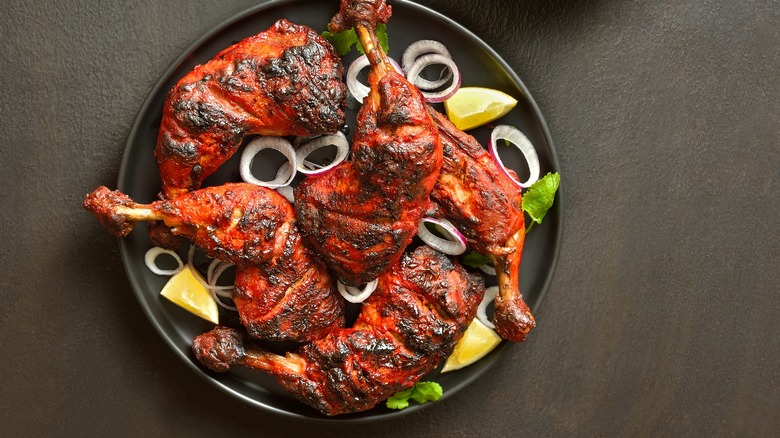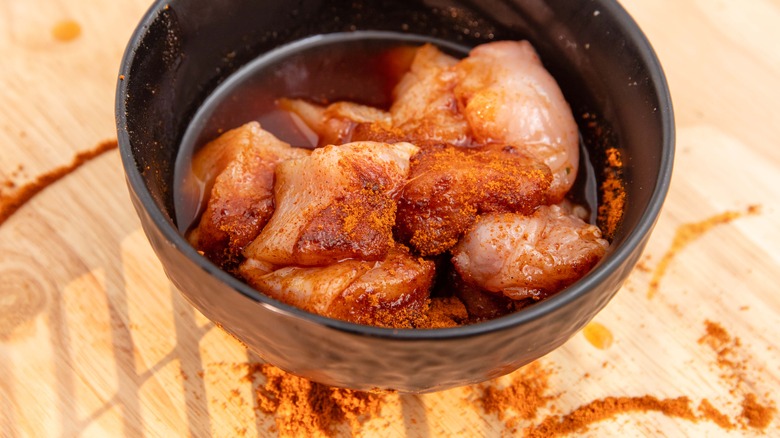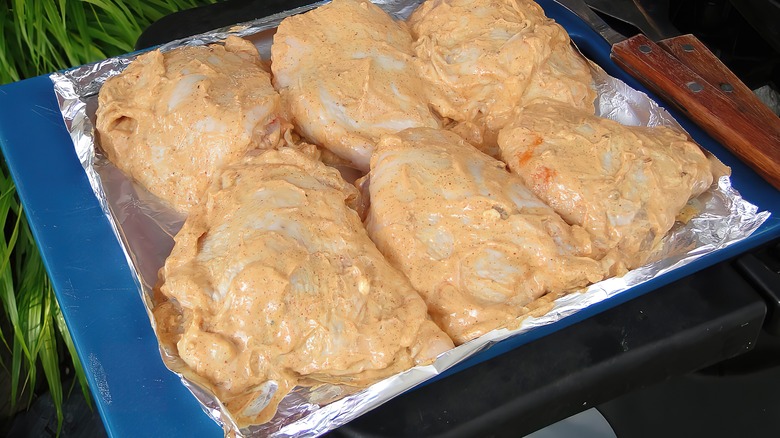The Marinade Tip For The Juiciest Tandoori Chicken Of Your Life
Not every chef does it. Some chefs do it but don't necessarily tell you that's what they're doing. And some chefs will tell you there's no other way to make tandoori chicken: Double marinate it for the juiciest and most flavorful version of the dish. Placing the chicken in a quick bath with an acid base, and then steeping it in a traditional blend of yogurt and spices, creates a moist and delicious result with layers of flavor.
Tandoori chicken is traditionally cooked in a clay tandoor oven at temperatures as high as 800 degrees Fahrenheit. That high heat can push the juices out of the chicken, leaving it tough and dry. Even if, like most home cooks, you're not using a tandoor oven for chicken but are instead grilling it over a flame or roasting it in a conventional or convection oven, you're using high levels of heat. The two-step marination process, even though it takes time and some planning, will help the chicken maintain its juices.
What's the difference between the first and second marinade?
The first marinade uses a citric acid base, usually lemon or lime juice, with a blend of spices. Most recipes suggest cutting shallow slits into the chicken before applying the marinade so it gets below the surface. Once applied, the acid starts to break down the connective tissue, called collagen, inside the meat. The acid also causes the muscle proteins to swell, allowing more moisture inside. Because citric acid is strong and can break down the muscle tissue to the point where the meat gets stringy, the chicken is left to rest in this marinade for just 15 to 30 minutes.
The second marinade is when the true characteristics of tandoori chicken come in. The marinade almost always starts with a thick yogurt base and includes a blend of Indian spices for tandoori chicken. Yogurt is an ideal base because it contains lactic acid, which also breaks down collagen and muscle fibers. However, lactic acid is gentler and tenderizes meat more slowly. Keeping the chicken in this marinade for several hours will also add a unique depth to the dish by allowing it to absorb the sugars inherent in the yogurt. Once in the oven or on the grill, those sugars will caramelize and create a crust around the chicken, giving it a slight crunchiness and succulence at the same time.
Additional tips for making the juiciest tandoori chicken
The best way to make sure your tandoori chicken stays moist is to leave it in the second marinade as long as possible. The longer it sits, the more tender and flavorful it will be. But once you start applying heat, the proteins in the chicken will start to bind together again and squeeze out the moisture. There are a few other tips for making tandoori chicken to make sure it stays juicy. Start by selecting the right parts of the chicken. Bone-in thighs and legs are fattier and are more likely to stay moist in high heat. Chicken breasts tend to dry out too quickly.
Some chefs recommend basting the chicken with butter or oil every 10 or 15 minutes as it cooks. This is especially important when roasting it in the oven, where it will take longer to cook. Another trick, borrowed from Chinese cooking, is to add baking soda to the marinade. Baking soda raises the pH of the chicken — the opposite effect of the acidic marinades. A higher pH on the surface of the meat prevents the proteins from binding together too tightly and squeezing the moisture out during cooking.
Yes, the double marination method takes patience. As the old adage says, good things come to those who wait. And getting to enjoy the juiciest, most flavorful tandoori chicken you've ever had is certainly worth this wait.


